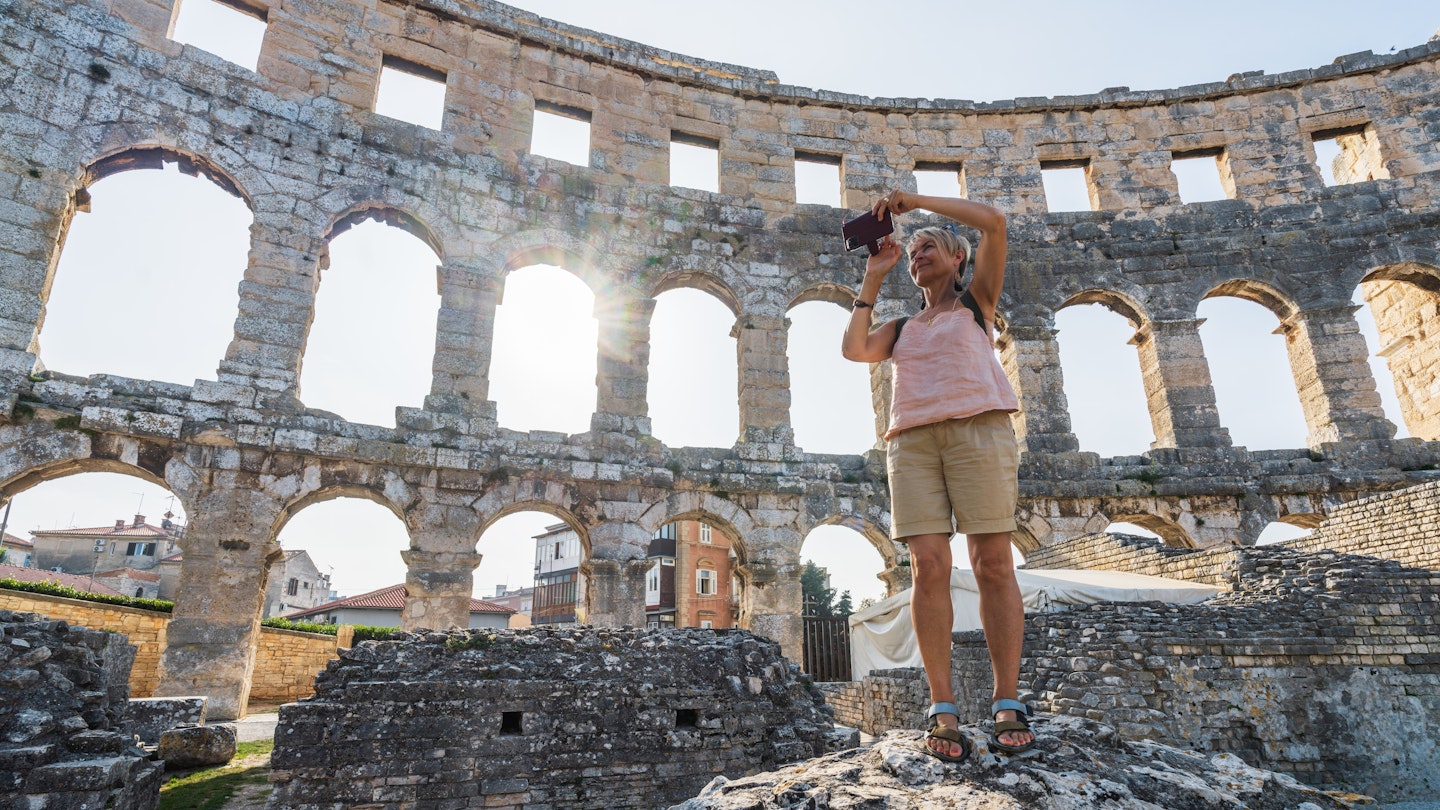Discover Istria’s Roman Heritage with GoTravelDaily
One of Istria’s most celebrated monuments is the Arena, the magnificent 1st-century Roman amphitheater that symbolizes Pula, the peninsula’s biggest city. This sea-facing amphitheater is not only an icon of ancient Rome but also represents the grandest and best-preserved example of the Romans’ everlasting impact on Istria.
In addition to the Arena, there are plenty more astonishing Roman-era monuments to explore in Pula as well as in Poreč and on the nearby Brijuni Islands. While spending time in Istria, visitors are bound to come across vestiges of its Roman past through ancient relics and architectural testaments that have withstood the test of time.
A Past Marked by Emperors, Rulers, and Monarchs
Istria endured centuries under the Roman Empire, followed by an array of Italian and German kingdoms. From 1331 to 1797, the Venetian Republic held sway. Subsequently, the peninsula was ruled by the Austrian Habsburgs and briefly by Napoleon before returning to Austro-Hungarian governance for over a century. After World War I, Istria became part of Italy, before finally joining Yugoslavia in 1947. Following the breakup of Yugoslavia in 1991, Istria became one of Croatia’s 20 counties.
Among the various kingdoms, republics, and empires, the Romans ruled Istria the longest – for over 650 years, from 177 BCE to the fall of their empire in 476 CE. During this significant period, the Romans made their mark by constructing orderly cities with stone-paved streets, grandiose buildings, and expansive olive groves. They also erected memorial arches, majestic temples, and open-air theaters.
Tracing Pula’s Rich Roman Past
The city of Pula boasts the largest number of remaining ancient Roman relics in Istria. The iconic Arena, constructed entirely of limestone, dates back to the 1st century and is one of only four remaining Roman amphitheaters in the world still in use today.
The best way to experience the Arena’s vibrant atmosphere is during its annual film festival or at one of the many summer concerts, where visitors can sit under the stars among its ancient stones, evoking the spirit of the 20,000 Roman spectators who once gathered to watch gladiators battle here.
On Trg Portarata stands the Arch of the Sergii, a triumphal arch built in 27 BCE that was once among the city’s 12 gates. This arch opens onto a cobblestone lane that leads to a cluster of narrow pedestrian streets. Visitors should search for the well-preserved 3rd-century Roman floor mosaics, once the exquisite floors of a Roman villa.
At the heart of Roman “Pola” was the Forum, a vast square dominated by the pillared Temple of Augustus, constructed sometime between 2 BCE and 14 CE. Visitors can pause at one of the many cafés surrounding the square and take in the architectural vestiges of the Roman past that have made this gathering place significant for millennia.
Pula’s 1st-century small Roman theater was recently restored and opened to the public, breathing new life into the ancient structure. During the summer, this semi-circular theater seats up to 1700 people for intimate open-air concerts, theater productions, and other cultural events.
Poreč: Istria’s Ancient Roman Capital
Tucked away on a narrow peninsula, the Roman past of the old town of Poreč is unmistakable. During Roman times, this seaside city was known as Parentium and served as the capital of Istria.
The car-free old town features a grid of cobblestone lanes, while the Decumanus serves as its main east-west thoroughfare, intersecting with the north-south Cardo Maximus.
The square Trg Marafor is home to the Roman Forum, the ancient city’s central hub, now vibrant with sidewalk cafés and restaurants. Nearby lie the age-old remains and stone columns of the Temple of Neptune, dedicated to the sea god and built in the 1st century.
Poreč’s star attraction is the magnificent Episcopal Complex of the Euphrasian Basilica, a UNESCO World Heritage Site that stands as one of the finest examples of Byzantine art and architecture in Europe. Dating back to 553 CE, this complex includes an early Christian church, an atrium, a baptistery, and an episcopal palace.
Visitors stepping into the basilica can admire the dazzling Byzantine mosaics of gold leaf adorning its semi-circular apse. Those venturing between July and September may find opportunities to enjoy classical music during weekly concerts set against this splendid backdrop.
On the Roman Trail on Veliki Brijun Island
Once a summer residence for Yugoslav president Tito, the Brijuni Islands, situated off Istria’s southwestern coastline, are now recognized as one of Croatia’s six national parks. Veliki Brijun, the largest island, showcases a collection of stunning Roman ruins and relics.
On the edge of Dobrika Bay lie the stone remains of a Byzantine Castrum, an ancient settlement fortified by thick defensive walls and the sea. Initially built as a villa by the Romans in the 1st century, it expanded during the 4th century, covering almost one hectare. Visitors can explore the maze of ancient stones and discover olive presses, cellars, cisterns, and brick ovens left behind by its residents.
The Roman Villa, a once-lavish summer residence perched on the edge of Verige Bay, reveals stone foundations from the 1st century. Here, two colonnaded peristyles and stone steps leading to circular baths can still be seen. Standing among these ancient stones evokes visions of a grand complex adorned with intricate mosaics and frescoes.
Another highlight from the Roman era is the island’s massive 1600-year-old olive tree, one of the remaining trees from what was once an extensive Roman olive grove. In ancient times, olive oil produced in Istria was exported via terracotta amphorae throughout the empire. Even today, the tree produces olives, which are harvested and pressed for oil each season.





